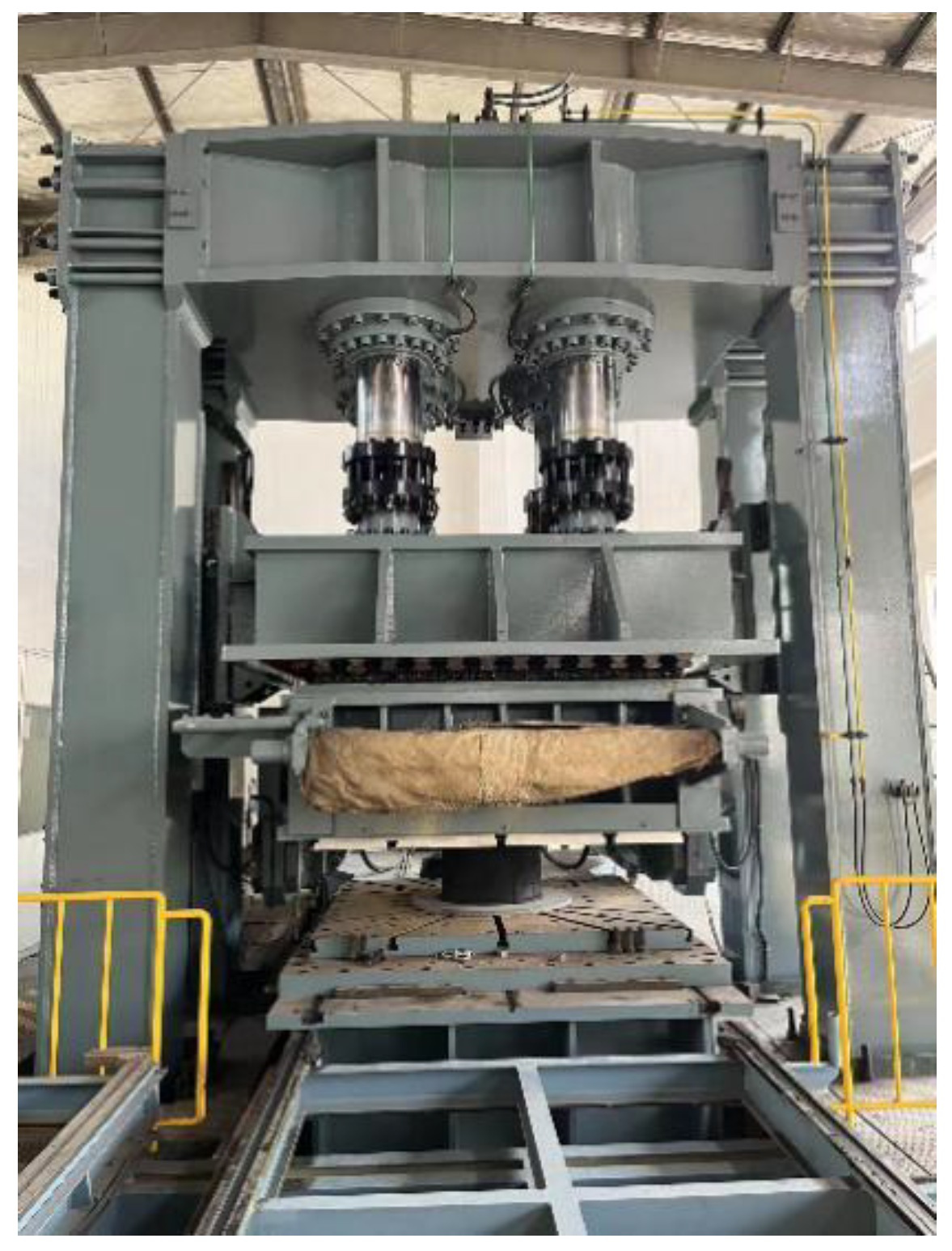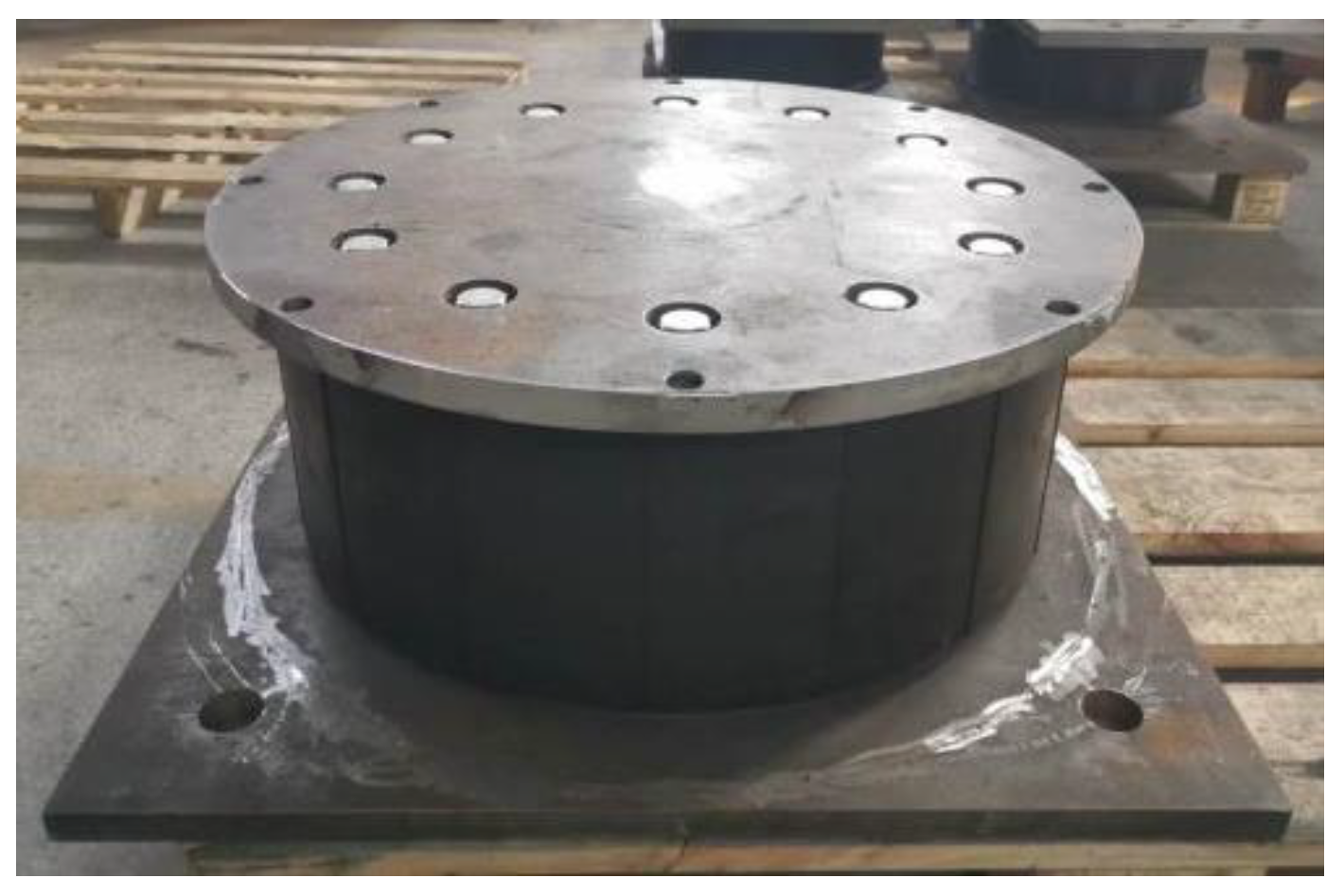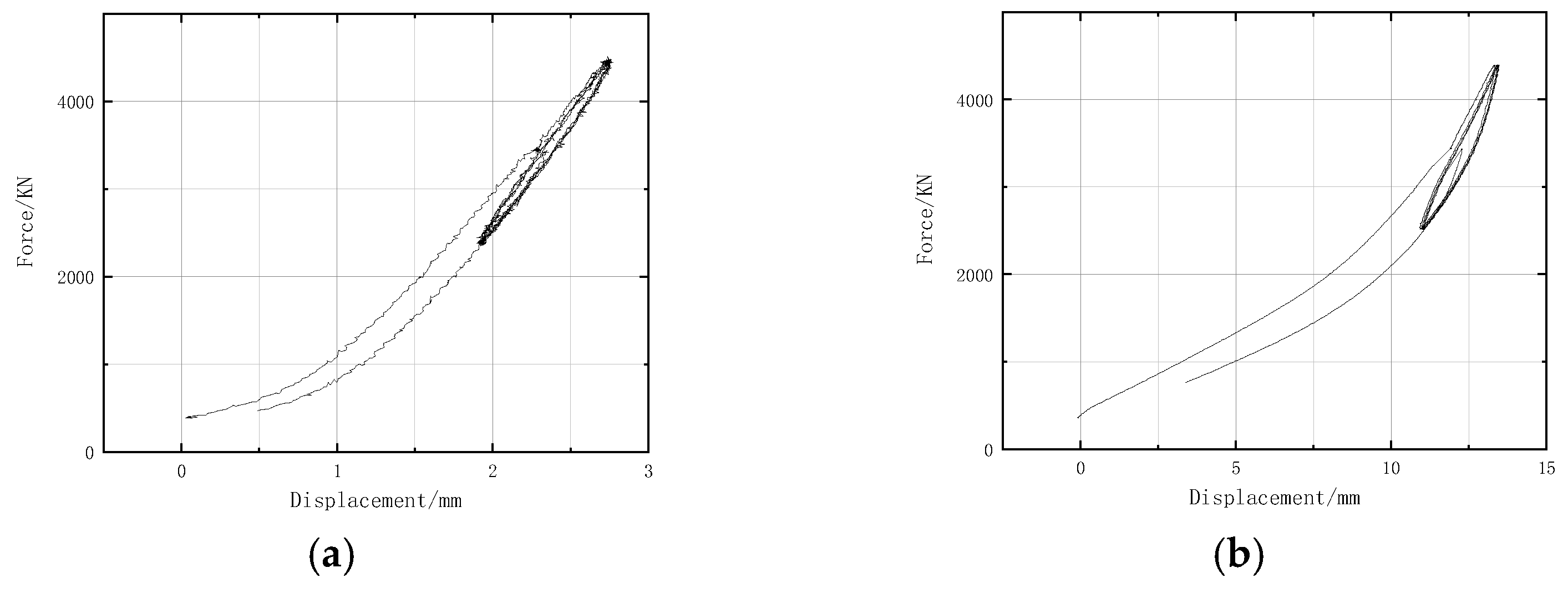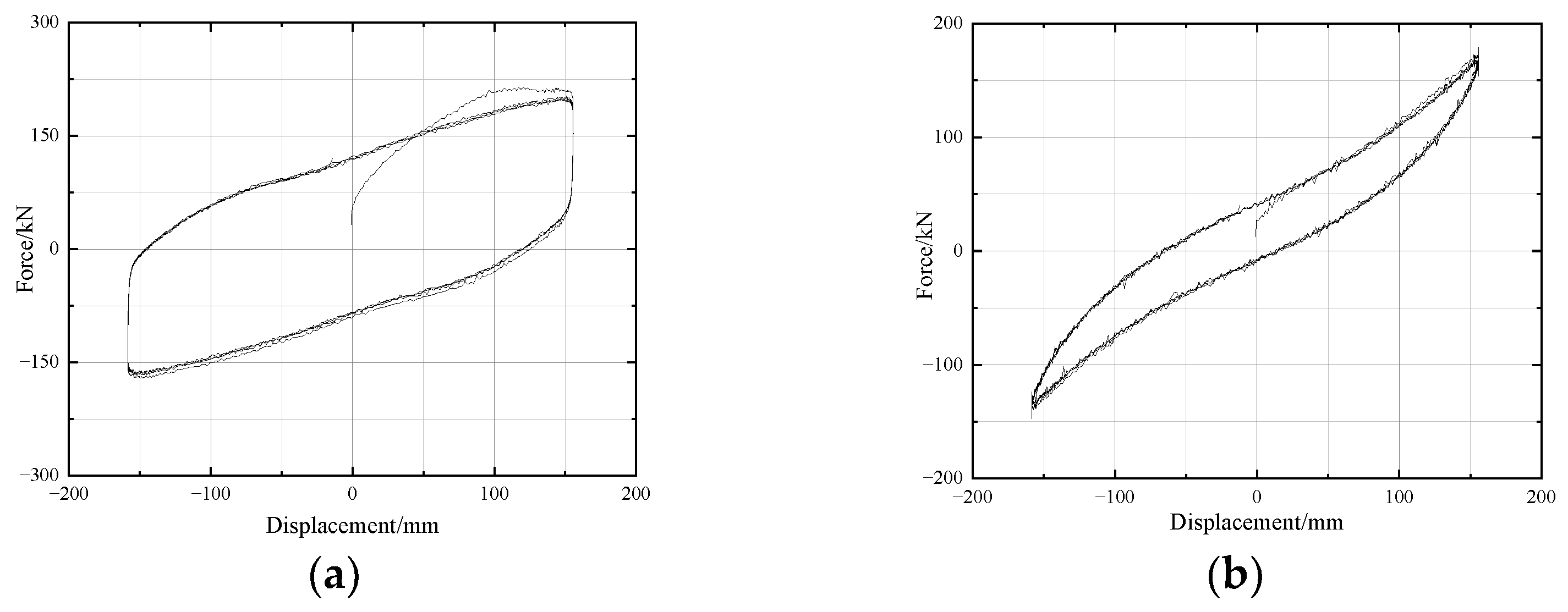Earlier in this paper, a constitutive model for rubber bearings was established, which considers the effect of vertical pressure and is more suitable for isolated structures. Two large-span isolated structures with different types of isolation bearings (equipped with LRB or TNRB-DSB) and one large-span non-isolated structure were designed to be the analysis objects. Based on the established models, the finite element method was used to investigate the seismic response characteristics of the large-span isolated structure under the action of the TNRB vertical isolation device and multiple earthquakes.
4.1. Structure Overview
The roof of the large-span isolated structure is a steel grid with an orthogonal normal four-pyramid structure, with a plane size of 60 m × 120 m, a height of 5.2 m, and a mesh size of 6 m × 6 m. The lower part is a two-layer reinforced concrete frame structure supported by peripheral columns, with the same story height of 5 m. The peripheral columns, the frame columns, the main girders, and the secondary beams were designed properly with section forms, sizes, and reinforcement detailing. The upper chord layer of the grid roof was subject to a uniform constant load of 0.55 kN/m
2 and a live load of 0.5 kN/m
2. The lower chord layer was subject to a uniform constant load of 0.30 kN/m
2 and a live load of 0.30 kN/m
2. Q345 and C40 were selected for steel and concrete materials, respectively. The structural damping ratio takes was 0.02. All the isolation bearings of the structure were placed between the bottom plate of the first floor and the foundation. The diameters of the bearings were calculated to be 600 mm under the conditions of permanent load and variable load. In SAP2000, the link units were used to simulate rubber isolators. The test values for the stiffness and damping ratio of the bearings were input when the support attributes were defined. The three-dimensional finite element model is shown in
Figure 7. As with the distribution of supports, dozens of LRBs were arranged around the perimeter of the structures. NRBs or TNRB-DSBs were arranged in the remaining positions of the structures. Some LRBs needed to be arranged to provide sufficient yield force to the structures.
The following assumptions were adopted in the calculation and analysis of the grid structure: (i) an ideally hinged connection pattern was selected for all nodes; (ii) all external loads acted on the joints of the grid roof; (iii) the upper roof structure worked with the lower support structure, and the influence of the wall on the structural stiffness could be ignored; and (iv) it was assumed that none of the reinforced concrete members in the model have reached the fatigue limit. In order to comprehend the dynamic characteristics of the large-span structure, the general finite element software SAP2000 was used to conduct a modal analysis of the structure. The first 11 orders of the natural vibration periods are listed in
Table 6.
The natural vibration period of the Model I isolated structure is 1.23 times that of the Model II isolated structure, while it is 4.27 times that of the non-isolated structure. For the Model II structure, the mass participation coefficient of the first three order modes is large, successively expressing the y-translational motion, x-translational motion, and z-torsional motion. For the Model I structure, the mass participation coefficients of the mode shape of the first three orders are rather large, and the main modal performances of the first three orders are the same as that of the Model II structure.
4.3. Structural Seismic Response Analysis
- (1)
Vertical acceleration response
The effectiveness of existing buildings after the installation of seismic isolation devices will be affected by the vertical seismic input. In
Figure 9 and
Figure 10, the values of 0, 1, 2, and 3 on the x axis refer to the seismic isolation layer, the first layer, the second layer, and the upper-grid layer of the structures.
The following can be seen from the above figures: (1) Different seismic input methods have a great influence on the vertical absolute acceleration of the grid layer, for both the non-seismic and seismic isolation structures. For instance, compared with the vertical seismic input, the peak vertical absolute acceleration of the grid layer for the non-isolated structure under the 3D seismic actions of the El Centro wave, Taft wave, and Artificial wave presented a decrease of 47.1%, 65.8%, and 50.6%, respectively. Accordingly, the peak vertical absolute acceleration of the grid layer for Model I isolated structures increased by 53.9%, 53.2%, and 53.9%, respectively, indicating that the multidimensional characteristics of earthquakes and the spectral characteristics of seismic waves are non-negligible. (2) For the Model I structure, when subjected to the 3D and vertical seismic inputs, the maximum structural seismic isolation rate reached 75.9% (Taft wave condition) and 12.7%. This illustrates that the vertical isolation effect under the 3D seismic input is significantly better than that under the vertical seismic input. This is because considering the horizontal seismic component is conducive to achieving vertical seismic isolation. (3) There is no obvious difference between the vertical acceleration of the Model I and Model II structures, indicating that the seismic isolation effect of the Model I structure is comparable to that of the vertical acceleration response of the Model II structure.
- (2)
Vertical displacement response
Figure 11 and
Figure 12 show the vertical peak displacement response results of the three structural models.
The following can be seen in
Figure 11: (1) Under the 3D seismic input, the vertical displacement amplitudes of the seismic isolation layer of the Model I and Model II structures are 0.291 mm and 0.337 mm (allowable value = 0.75h
0 = 4.2 mm); (2) The deflection values of the grid roof of the non-seismic isolated structure for the Model I and Model II structures are 48.5 mm, 49.0 mm, and 48.8 mm, respectively (the limit = L
2/250 = 0.24, L
2 is the short span of the roof); (3) Compared with the Model II structure, the peak vertical displacement of the grid layer of the Model I structure has a maximum increase of 1.6%, which is mainly because the addition of the vertical isolation component, DSB, in the TNRB-DSB reduces the vertical stiffness of the isolation layer to a certain extent. However, the reduction is non-significant.
Through a comparison of
Figure 11 and
Figure 12, the following points can be noted: (1) The two seismic input methods have a great influence on the vertical displacement of the grid layer for all three structures. For example, compared with the 3D seismic input, the peak vertical displacement of the grid layer for the non-isolated structure under the vertical seismic actions of the El Centro wave, Taft wave, and artificial wave presented an increase of 38.1%, 40.5%, and 51.1%, respectively. Accordingly, those displacement responses for both the two isolated structures under three 3D seismic actions increased by 53.9%, 53.9%, and 54.0%, respectively; (2) Under the 3D seismic input, the maximal displacement difference for the Model I structure under the three seismic waves was 23.9 mm, which also shows the significant influence of spectral characteristics on the structural responses; (3) The vertical displacement responses of the isolated structures are basically smaller than those of the non-isolated structure, under the action of different seismic waves and different input modes; (4) The vertical displacement response law of the two isolated structure models stayed consistent under the three seismic waves.
- (3)
Horizontal acceleration response
The peak horizontal absolute acceleration results of structures under 3D seismic input and vertical seismic input are shown in
Figure 13 and
Figure 14.
Figure 13 and
Figure 14 show the following: (1) Under the 3D seismic input, the peak horizontal absolute acceleration response results are much larger than those under the vertical seismic input, which is consistent with people’s conventional cognition. (2) Under the 3D seismic input for the Taft wave and artificial wave, the horizontal acceleration response values of the Model I structure are smaller than those of the Model II structure. When subjected to the El Centro wave, the response values of the former structure become greater than those of the latter structure, indicating that the former has a better horizontal seismic isolation effect. When the vertical seismic input occurs, the horizontal acceleration curves of the two isolated structures basically coincide. (3) Compared with the non-isolated structure, the peak horizontal acceleration responses of the two isolated structures are greatly reduced under different seismic inputs, which reflects an excellent horizontal seismic isolation effect. (4) Under the 3D seismic input, the horizontal absolute acceleration of the seismic isolation layer is slightly higher than that of the frame layers. Under the vertical seismic input, the horizontal absolute acceleration response values of the three large-span structures showed an increasing trend with the increase of floors.
- (4)
Interlayer displacement response
The interlayer displacement results of the three models are shown in
Figure 15 and
Figure 16.
The following can be seen in
Figure 15 and
Figure 16: (1) Under the 3D input method, the largest horizontal interlayer displacement for the two isolated structures occurs in the seismic isolation layers (limited value = 0.55 D
min = 330 mm). After the seismic wave propagates upward through the isolation layer, the interlayer displacement results of the superstructure of the Model I structure are not obviously different from those of the Model II structure. However, the horizontal displacement of the seismic isolation layer is greatly affected by the horizontal seismic action under different input modes of seismic waves. (2) Under the action of the vertical seismic input, all the interlayer displacement values of the grid layer of the Model I structure do not exceed those of the Model II structure. However, there is no obvious difference in the interlayer displacement response results under the 3D seismic input. (3) The two seismic input methods have a great effect on the horizontal interlayer displacements of the seismic isolation layer. The interlayer displacements of the seismic isolation layer under the 3D seismic input are thousands of times those under vertical input. For the remaining floors, the influence of the two seismic input methods is reflected in the increasing trend of the inter-floor displacement along with the growth of the floor.
The maximum story drift, including the 1st floor, 2nd floor, and the grid layer, are shown in
Table 7.
In the above table, it can be observed that the maximum story drift of the three models under rare earthquakes are 1/393, 1/1061, and 1/832, which comply with the provisions of the Code for Seismic Design of Buildings [
16] (limit value = 1/50, for reinforced concrete frame structures).
- (5)
Analysis of the influence of seismic input methods
The following discussion concerns the impact of two seismic input methods on the vertical seismic response results of the Model I structure.
Table 8,
Table 9 and
Table 10 provide the comparison of vertical acceleration, vertical displacement, and horizontal acceleration under two seismic inputs. Error is defined as the result of (response results under 3D input—response results under vertical input)/response under the 3D input. It should be noted that the horizontal displacement of the isolation layer varies greatly under the two seismic input methods, which need not be discussed here.
As can be seen in the three tables above, compared to vertical seismic input, the vertical acceleration of each floor of the Model I isolated structure under 3D seismic input has a decrease extent of more than 50%. The error of structural vertical displacements is in the range of −55% to 26%. The structural horizontal acceleration results present an increase extent of more than 40%. However, the vertical input will weaken the horizontal acceleration response results of the structures, while the horizontal input will weaken their vertical acceleration response. The above results fully illustrate that in the analysis of the isolated structure’s response, the multidimensional characteristics of earthquakes cannot be ignored.



























